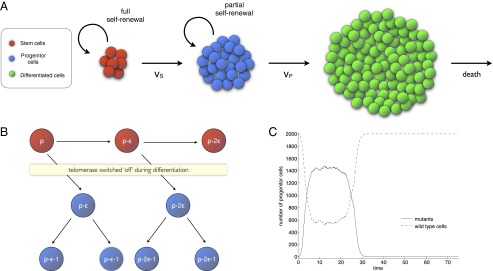Fig. 2.

(A) Cell lineage model. Cells are divided into three compartments: stem cells, progenitor cells, and differentiated cells. Stem cells have a full capacity to self-renew and maintain their own number through self-replication. Progenitors have only a limited capacity to self-renew. The final products are the fully differentiated cells, which die at a certain rate. (B) Replication capacity of cells decreases upon cell division. Adult stem cells express telomerase, which at least partially offsets the shortening of telomere length that occurs when a cell divides. As a consequence, the loss in replication capacity of stem cells is smaller than the loss that occurs in progenitors (equal to 1 in the figure). (C) Dynamics of a mutant clone originating in a progenitor cell. At time , a mutation originates in a progenitor. The number of mutants first steadily increases and then remains very close to a constant level (partial fixation occurs). As the replication capacity of the mutants is gradually exhausted, their numbers drop and the mutant clone eventually goes extinct.
